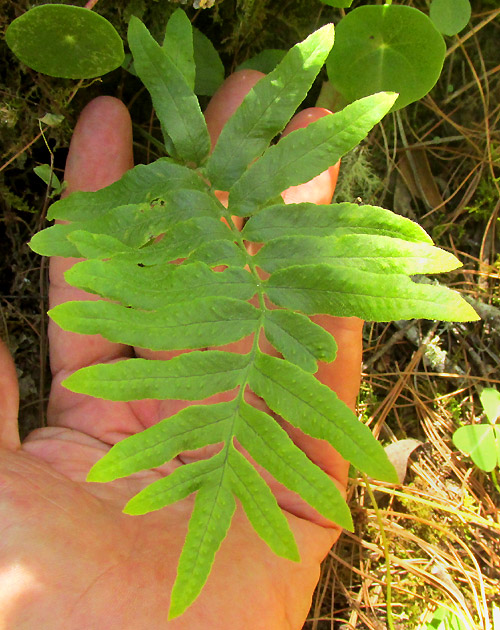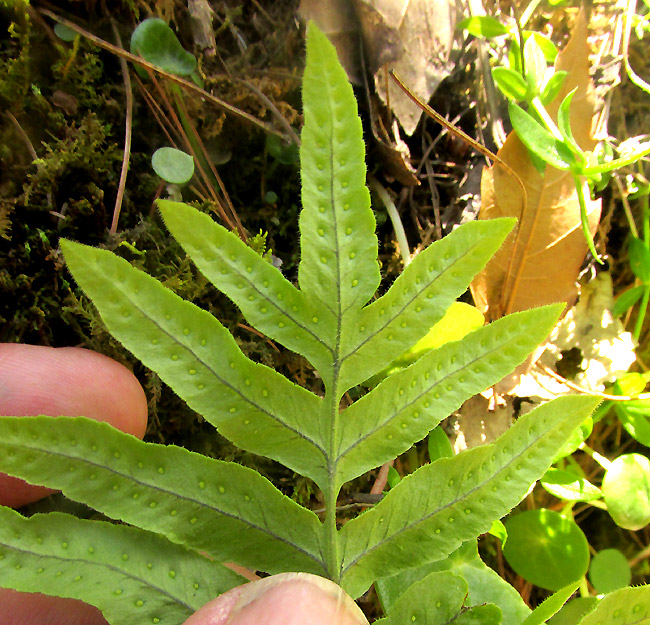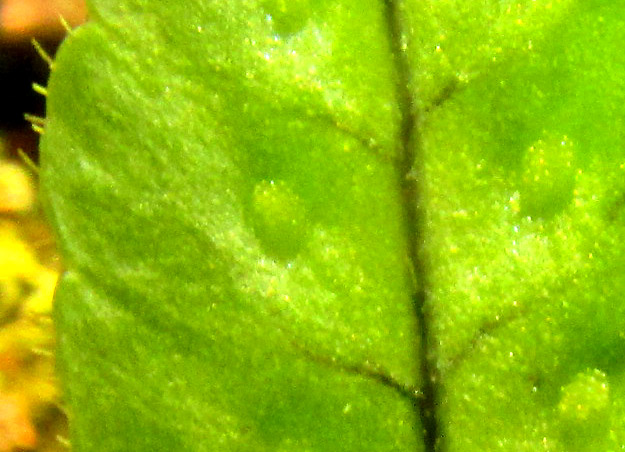Excerpts from Jim Conrad's
Naturalist Newsletter
Entry from field notes dated September 2, 2023, taken in Los Mármoles National Park in the Eastern Sierra Madre mountains, Hidalgo state, MÉXICO; near ridgetop along road leading to Puerto de Piedra, which branches off the road between Trancas {on maps designated "Morelos (Trancas)"} and Nicolás Flores; limestone bedrock; elevation ~2,550m (~8,400ft); ~N20.81°, ~W99.23°
FALSE GOLDEN POLYPODY

On moss-covered boulders and soil of a north-facing, steep slope, the above was the only fern amid an impressive community of the plants with the circular leaves at the picture's top, Peperomia bracteata. Anatomically, it's a simple fern, like one designed by a child, but note the very slight rows of small bumps atop each leaflet, or pinna. The bumps reveal the presence of reproductive sori on the blade's lower surface.

Above, round sori line up in single file on both sides of each pinna's midvein. These are very immature sori, shown closer up below:

Inside each developing sorus, tiny pale specks are visible. Each speck will develop into a sporangium, and each sporangium will produce 64 spores, a fact helping us visualize how small fern spores are. The sori are so immature that it's hard to say whether they will develop papery indusia which will shelter the developing sporangia, a feature found on many fern species. At at this early stage of sorus development there's no hint of indusia forming.
However, in fern identification, it's important to know the indusium situation. From what's seen so far, a good guess is that our fern will produce round sori without indusia. This suggests the Polypody Family, the Polypodiaceae.
In our part of upland central Mexico, if you have a member of the Polypody Family with fronds divided once into less than 35 pinnae per frond, you have one of two genera: Polypodium or Phlebodium. The two genera are distinguished by whether each sorus is attached to just one or else two or more veins. On our immature plant the veins aren't evident.
However, from my limited experience, our fern looks and behaves more like a Phlebodium; for example, I've met the Hares-foot Fern and the Calaguala Fern, both Phlebodium species.
The 2021 study by José Luis Villaseñor and others entitled "Riqueza y distribución de la flora vascular del estado de Hidalgo, México" lists just one Phlebodium species documented as occurring in our upland central Mexican state of Hidalgo. It's fairly widely distributed here, and our fern with its simple design, and ten or so pairs of pinnae with the lowest pair a little smaller and angled backwards a bit, looks exactly like the species occurring here. It's PHLEBODIUM PSEUDOAUREUM, on the Internet and in publications often referred to as the False Golden Polypody, a name translated directly from the bionomial. It's called a polypody because earlier the species was assigned to the polypody genus, Polypodium.
Phlebodium pseudoaureum occurs in many moist environments, from chilly cloud forests to hot lowland rainforests and in-between oak-pine forests, throughout the tropical and subtropical Americas -- even turning up in Florida's swamps and hammocks in the US. In temperate zones, if you have a hothouse filled with potted tropical plants, there's a good chance this species will invade the pots.
In the 2018 study by Armando Cáceres and Sully Cruz entitled "Application of Calahuala (Phlebodium spp) fern complex for the formulation of diverse medicinal and cosmetic products," it's stated that Phlebodium pseudoaureum is used in traditional Mexoamerican medicine for the treatment of various chronic diseases. Water extracts of the rhizomes and fronds are used to treat "... respiratory, urinary and cardiac diseases, gastric ulcer, broken bones, rheumatism, tumors, and skin diseases (psoriasis, dermatitis, vitiligo, and sunburn)." Their studies conclude that the extracts are effective and safe. Particularly they recommend the extract for treating vitiligo (chronic disorder causing patches of skin to lose pigment or color), psoriasis and as a photoprotector against sunburn.